Light Duty Bridge Crane for Sale, Get Your Design & Solution
Light duty crane for sale, good price. Custom light duty cranes for your needs, get your light duty overhead cranes, light duty gantry cranes,light duty jib cranes.
In the field of manufacturing, where precision and efficiency are paramount, light duty bridge cranes stand as stalwart companions, streamlining operations and enhancing productivity. Let's embark on a journey to explore the essence and significance of these invaluable tools.
Light duty bridge cranes, also known as single girder overhead cranes, are sophisticated lifting systems meticulously engineered to handle small parts and light loads with finesse and precision. Their purpose is rooted in providing a reliable and efficient means of material handling within manufacturing workshops, where every movement plays a crucial role in maintaining seamless operations.
Key Features and Components
- Single Girder:At the core of a light duty bridge crane lies a single beam, known as the girder, which forms the backbone of the lifting structure. This girder provides stability and support for the entire crane system.
- Hoist and Trolley:Mounted on the girder, the hoist serves as the workhorse of the crane, responsible for lifting, lowering, and maneuvering loads with utmost control and precision. The trolley, equipped with wheels or a rail system, facilitates horizontal movement along the length of the girder, allowing for precise positioning of the load.
- End Trucks:Positioned at each end of the girder, the end trucks house the wheels or mechanisms that support and guide the trolley along the span. These components ensure smooth and stable movement of the crane across the workshop.
- Controls:Modern light duty bridge cranes are equipped with advanced control systems, ranging from traditional push-button pendants to state-of-the-art wireless remote controls. These intuitive interfaces enable operators to command the crane with ease and precision, enhancing overall efficiency and safety.
Benefits of Using Light Duty Bridge Cranes
- Enhanced Efficiency:By providing a swift and reliable means of transporting small parts and light loads, light duty bridge cranes streamline production processes, reducing handling time and optimizing workflow efficiency.
- Space Optimization:With their compact design and ability to operate within limited overhead clearance and floor space, these cranes maximize the utilization of workshop real estate, ensuring optimal spatial efficiency.
- Versatility:Light duty bridge cranes are highly adaptable and customizable to suit various applications and industries, offering versatility in handling a diverse range of loads and materials.
- Cost-Effectiveness:Compared to larger and more complex crane systems, light duty bridge cranes present a cost-effective solution for small and medium-sized businesses, offering high performance at a reasonable investment.
- Safety:Equipped with advanced safety features such as overload protection and emergency stop systems, these cranes prioritize workplace safety, minimizing the risk of accidents and ensuring a secure working environment for operators and personnel alike.
In essence, light duty bridge cranes embody efficiency, reliability, and safety, serving as indispensable assets in the modern manufacturing landscape. Their seamless integration into production workflows empowers businesses to optimize operations, maximize productivity, and embark on a journey towards sustainable growth and success.
Light Duty Bridge Crane Classification
In the realm of material handling equipment, classification is key to understanding the capabilities and limitations of various systems. Let's delve into the specifics of light duty bridge crane classification to gain a comprehensive understanding of its nuances.
When we refer to light duty classification in the context of bridge cranes, we're essentially categorizing cranes designed for handling relatively smaller loads and operating under less demanding conditions. These cranes are engineered with efficiency and cost-effectiveness in mind, catering to applications where heavy lifting and continuous operation aren't primary requirements.
Criteria for Classifying Bridge Cranes as Light Duty
Several factors contribute to classifying bridge cranes as light duty. These include:
- Load Capacity:Light duty bridge cranes typically have lower load capacities compared to their medium or heavy-duty counterparts. They are designed to handle loads ranging from a few hundred pounds to several tons, depending on the specific requirements of the application.
- Frequency of Use:Light duty cranes are intended for intermittent or occasional use rather than continuous operation. They are well-suited for applications where lifting needs are sporadic or where the workload is relatively light.
- Operating Environment:Light duty bridge cranes are typically deployed in environments with moderate to low levels of operational stress. They may not be suitable for harsh or demanding conditions that require robust construction and heavy-duty components.
- Span and Reach:The span and reach of light duty bridge cranes are often tailored to suit the spatial constraints of the application. These cranes are commonly utilized in workshops and facilities with limited overhead clearance and floor space.
- Speed and Precision:While light duty cranes offer sufficient speed and precision for handling small loads, they may not match the performance capabilities of higher-duty classifications in terms of speed or positioning accuracy.
Comparison with Other Duty Classifications
Light duty bridge crane classification stands in contrast to medium and heavy-duty classifications, which are characterized by higher load capacities, continuous operation capabilities, and robust construction. Here's a brief comparison:
- Medium Duty:Medium duty bridge cranes are designed for handling moderate loads and operating under more frequent or continuous usage conditions. They offer higher load capacities and enhanced durability compared to light duty cranes.
- Heavy Duty:Heavy duty bridge cranes are engineered for handling large and heavy loads in demanding industrial environments. They feature robust construction, high load capacities, and the ability to withstand rigorous operating conditions.
In essence, understanding the classification of light duty bridge cranes provides valuable insights into their suitability for specific applications and operational requirements. By aligning crane selection with the unique needs of each task, businesses can optimize efficiency, minimize costs, and ensure optimal performance in their material handling operations.
Types of Light Duty Bridge Cranes
In the field of light duty material handling, a variety of overhead crane configurations cater to diverse applications and operational requirements. Let's explore the features, benefits, and typical applications of each type: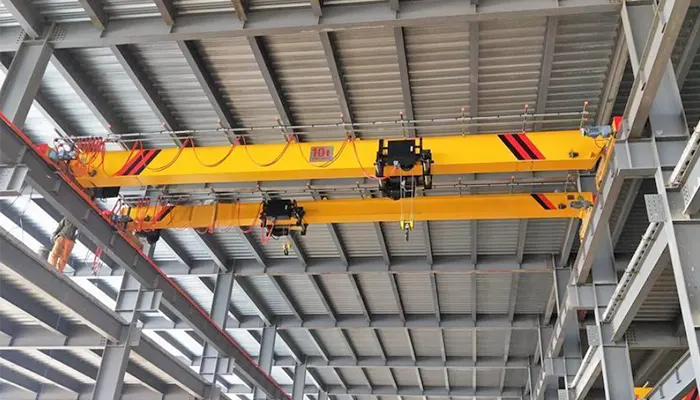
Features:
Utilizes a single beam (girder) supported at each end by the building structure.
Hoist and trolley system suspended from the girder for lifting and horizontal movement.
Compact design suitable for workshops with limited overhead clearance.
Benefits:
Cost-effective solution for light duty applications.
Easy to install and maintain.
Versatile and customizable to suit various lifting needs.
Typical Applications:
Manufacturing workshops
Warehouses
Assembly lines
Maintenance facilities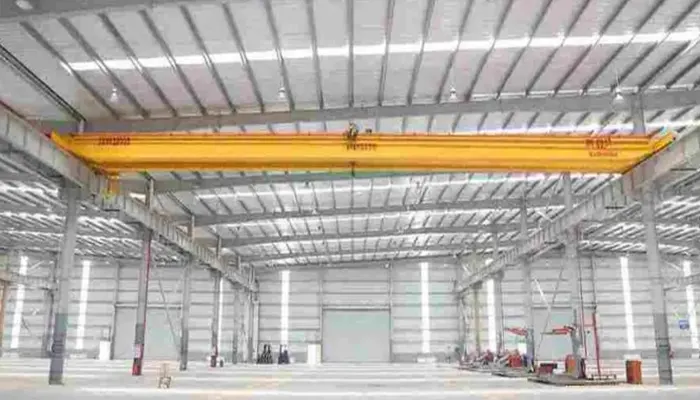
Features:
Utilizes two parallel girders for increased stability and load capacity.
Hoist and trolley system suspended between the girders for enhanced lifting performance.
Ideal for handling heavier loads and longer spans.
Benefits:
Higher load capacities compared to single girder cranes.
Greater lifting heights and spans.
Enhanced stability and precision in load handling.
Typical Applications:
Heavy manufacturing
Steel fabrication
Foundries
Power plants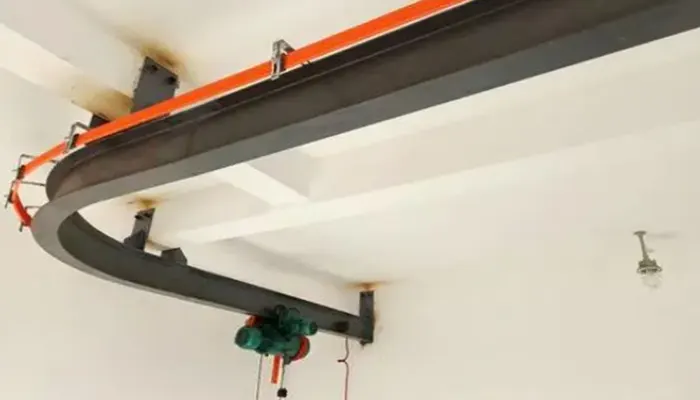
Features:
Consists of a single girder track mounted on overhead supports.
Hoist and trolley system travels along the track for horizontal movement.
Well-suited for linear material handling within a specific area.
Benefits:
Efficient use of space with minimal obstruction.
Easy to install and relocate.
Flexible layout options to accommodate changing production needs.
Typical Applications:
Assembly lines
Paint booths
Machining centers
Storage facilities
Features:
Designed to run on rails installed beneath existing roof structures.
Hoist and trolley system suspended from the bottom flange of the runway beam.
Ideal for facilities with limited headroom or overhead space constraints.
Benefits:
Maximizes floor space utilization.
Provides efficient material handling without obstructing overhead clearance.
Quick and straightforward installation process.
Typical Applications:
Low headroom buildings
Work cells
Clean rooms
Tool rooms
Features:
Modular system consisting of lightweight aluminum profiles and components.
Flexible configuration options for customizing lifting solutions.
Suitable for light duty applications requiring precise and ergonomic material handling.
Benefits:
Lightweight and easy to manipulate.
Quick assembly and reconfiguration.
Offers ergonomic benefits for operators.
Typical Applications:
Workstations
Assembly areas
Maintenance shops
Laboratories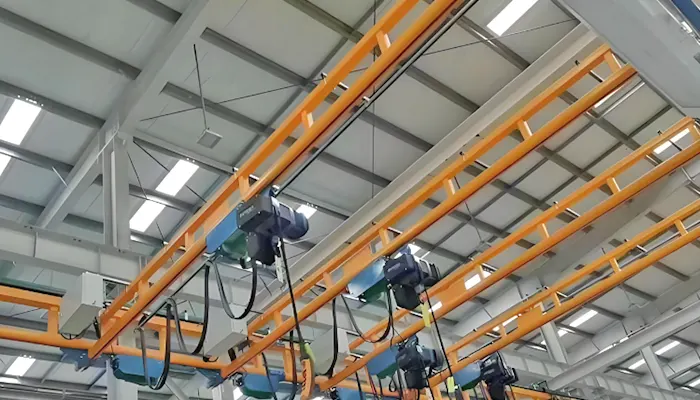
Workstation Bridge Cranes
Features:
Designed for installation directly over workstations or assembly areas.
Manual or powered hoist and trolley system for ergonomic material handling.
Provides localized lifting solutions for specific tasks.
Benefits:
Improves efficiency and productivity at individual workstations.
Reduces strain and fatigue on operators.
Enhances safety by minimizing manual lifting and handling.
Typical Applications:
Manufacturing cells
Assembly stations
Quality control areas
Packaging lines
In summary, each type of light duty bridge crane offers unique features, benefits, and applications tailored to specific material handling needs. By understanding the characteristics of each crane type, businesses can make informed decisions to optimize efficiency, productivity, and safety in their operations.
Advantages of Light Duty Bridge Cranes
Light duty bridge cranes, with their tailored design and capabilities, offer a multitude of advantages for material handling in various industrial settings. Let's delve into the specific benefits they bring to the table:
Precision and Control
Precision Handling:Light duty bridge cranes are equipped with advanced controls that enable operators to maneuver loads with precision, ensuring accurate placement and minimizing the risk of damage or errors.
Smooth Operation:The ergonomic design of light duty cranes, coupled with intuitive control interfaces, allows for smooth and controlled movement of loads, enhancing overall operational efficiency.
Cost-Effectiveness
Affordable Investment:Light duty bridge cranes represent a cost-effective solution for businesses looking to optimize their material handling processes without breaking the bank. Their relatively lower upfront costs make them accessible to a wide range of industries and applications.
Operational Efficiency:By streamlining material handling operations and minimizing downtime, light duty cranes contribute to improved productivity and cost savings over time, offering a favorable return on investment.
Versatility and Adaptability
Customizable Configurations:Light duty bridge cranes can be tailored to suit specific application requirements, with options for adjustable spans, lifting capacities, and control features, ensuring versatility in handling diverse loads and tasks.
Adaptability to Changing Needs:Their modular construction and flexible design make light duty cranes adaptable to evolving production environments, allowing businesses to scale operations and accommodate shifting demands with ease.
Space Efficiency
Maximized Floor Space:Light duty bridge cranes are designed to operate within limited overhead clearance and floor space, maximizing the utilization of available workspace without compromising on lifting capacity or performance.
Reduced Obstruction:Their compact footprint and overhead installation minimize obstruction on the shop floor, allowing for seamless movement of personnel and equipment below, and optimizing workflow efficiency.
Ease of Installation and Maintenance
Quick Installation:Light duty bridge cranes are typically straightforward to install, requiring minimal disruption to ongoing operations. Their modular components and pre-engineered designs facilitate rapid deployment, ensuring a swift transition to enhanced material handling capabilities.
Minimal Maintenance Requirements:With simplified construction and durable components, light duty cranes are easy to maintain, reducing downtime and associated costs. Routine inspections and preventive maintenance tasks help prolong the lifespan of the crane and ensure reliable performance over time.
In essence, the advantages of light duty bridge cranes extend beyond mere material handling, encompassing aspects of cost-effectiveness, efficiency, and adaptability. By harnessing these benefits, businesses can optimize their operations, enhance productivity, and stay competitive in today's dynamic industrial landscape.
Common Applications of Light Duty Bridge Cranes
Light duty bridge cranes find widespread use across a variety of industries and applications, owing to their versatility, efficiency, and precision in material handling. Let's explore some of the common scenarios where these cranes play a pivotal role: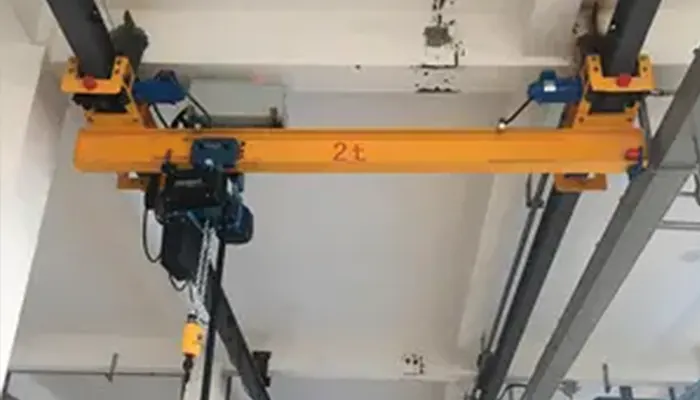
Manufacturing and Assembly
Component Handling:Light duty bridge cranes excel in transporting small parts, components, and assemblies within manufacturing facilities, facilitating smooth assembly line operations and ensuring timely production.
Workstation Support:They are frequently employed to provide localized lifting solutions at individual workstations, allowing operators to handle materials with precision and ease during assembly, testing, or quality control processes.
Warehousing and Logistics
Inventory Management:Light duty bridge cranes assist in organizing and managing inventory within warehouses, enabling efficient movement of goods between storage racks and packing areas, and optimizing space utilization.
Order Fulfillment:These cranes play a crucial role in picking and packing operations, facilitating the retrieval of items from shelves or pallets and transporting them to shipping stations for dispatch.
Automotive Industry
Production Lines:Light duty bridge cranes are integral to automotive manufacturing processes, aiding in the handling of car components, subassemblies, and finished vehicles along the production line, from stamping and welding to painting and final assembly.
Maintenance and Repair:They are utilized in automotive workshops and garages for lifting and positioning heavy equipment, engine blocks, and vehicle parts during maintenance, repair, and servicing operations.
Small Workshops and Garages
Equipment Handling:Light duty bridge cranes serve as indispensable tools in small-scale workshops and garages, facilitating the safe and efficient lifting of tools, machinery, and vehicle components for maintenance, fabrication, or repair tasks.
Material Transport:They aid in moving materials, such as metal sheets, lumber, or construction materials, within confined workshop spaces, eliminating the need for manual handling and reducing the risk of accidents or injuries.
Retail and Wholesale Distribution Centers
Stockroom Management:Light duty bridge cranes assist in managing stockrooms and distribution centers, enabling the swift and orderly movement of merchandise between storage areas and shipping docks, enhancing order fulfillment efficiency.
Handling Bulk Items:They are utilized for lifting and transporting bulk items, such as cartons, crates, and palletized goods, within retail or wholesale environments, streamlining logistics operations and reducing handling time.
In summary, the versatility and effectiveness of light duty bridge cranes make them indispensable assets across a wide spectrum of industries and applications, contributing to increased efficiency, productivity, and safety in material handling operations. Whether in manufacturing, warehousing, automotive, or retail settings, these cranes play a vital role in driving operational success and facilitating seamless workflow management.
Selection Guidelines for Light Duty Bridge Cranes
Selecting the right light duty bridge crane is crucial for optimizing material handling efficiency and ensuring workplace safety. Here are essential guidelines to consider when choosing a crane for your specific application:
Determining Load Capacity Requirements
Identify Typical Loads:Analyze the types and weights of materials or components that the crane will handle regularly. Consider both current and potential future load requirements.
Factor in Safety Margins:Choose a crane with a load capacity that exceeds your maximum anticipated load to account for unexpected variations or occasional heavier loads.
Assessing Span and Lift Height
Evaluate Workspace Dimensions:Measure the distance between support structures and determine the required crane span to cover the entire work area effectively.
Consider Vertical Clearance:Assess the height clearance available in the workspace to determine the required lift height of the crane, ensuring adequate space for load movement.
Considering Operational Environment
Environmental Conditions:Consider factors such as temperature extremes, humidity levels, dust, and corrosive substances present in the operational environment. Choose crane components and materials that can withstand these conditions.
Indoor vs. Outdoor Use:Determine whether the crane will operate indoors or outdoors, as this will impact considerations such as weatherproofing, corrosion resistance, and environmental protection measures.
Evaluating Safety Requirements
Compliance with Regulations:Ensure that the selected crane meets all relevant safety standards and regulations, including those set forth by regulatory bodies such as OSHA (Occupational Safety and Health Administration) or ANSI (American National Standards Institute).
Safety Features:Look for safety features such as overload protection, emergency stop controls, limit switches, and collision avoidance systems to minimize the risk of accidents and injuries.
Budgetary Considerations
Total Cost of Ownership:Consider not only the upfront purchase price of the crane but also long-term operating costs, including maintenance, repairs, and energy consumption.
ROI Analysis:Evaluate the potential return on investment (ROI) based on increased productivity, reduced downtime, and improved safety resulting from the use of the crane.
By carefully assessing load capacity requirements, workspace dimensions, operational environment, safety considerations, and budgetary constraints, you can make an informed decision when selecting a light duty bridge crane. Investing in the right crane for your specific needs will enhance efficiency, productivity, and safety in your material handling operations, ultimately contributing to the success of your business.
Where to Find Light Duty Bridge Cranes for Sale
When in need of a light duty bridge crane for your operations, various avenues offer access to a wide range of options. Here are some places to consider when looking to purchase a light duty bridge crane:
Manufacturers and Suppliers
Direct from Manufacturers:Reach out to reputable manufacturers of light duty bridge cranes to inquire about their product offerings. Many manufacturers provide customized solutions tailored to specific application requirements.
Authorized Distributors:Authorized distributors or dealers of crane manufacturers may offer a selection of light duty bridge cranes along with professional guidance and support throughout the purchasing process.
Online Marketplaces
E-commerce Platforms:Explore online marketplaces such as Alibaba, Amazon, or eBay, where a variety of light duty bridge cranes from different manufacturers and sellers are available for purchase. Be sure to review product specifications, customer reviews, and seller ratings before making a decision.
Specialized Websites:Visit specialized websites dedicated to industrial equipment sales, where you can find a curated selection of light duty bridge cranes from reputable sellers and manufacturers.
Equipment Auctions and Expos
Industry Events:Attend industry-specific trade shows, exhibitions, and equipment expos where manufacturers and sellers showcase their latest products, including light duty bridge cranes. These events provide an opportunity to compare different models, interact with vendors, and make informed purchasing decisions.
Online Auctions:Explore online auction platforms specializing in industrial equipment, where you may find used or surplus light duty bridge cranes available for purchase at competitive prices. Exercise caution and thoroughly inspect equipment before bidding to ensure quality and functionality.
Local Dealers and Distributors
Regional Distributors:Check with local distributors or dealers specializing in industrial equipment and machinery. They may carry a selection of light duty bridge cranes suitable for your needs and provide personalized assistance based on your specific requirements.
Equipment Rental Companies:Some equipment rental companies also offer light duty bridge cranes for sale, either as new or refurbished units. Contact local rental companies to inquire about purchasing options and availability.
When exploring these avenues to find a light duty bridge crane for sale, it's essential to conduct thorough research, compare options, and consider factors such as product quality, reliability, warranty coverage, and after-sales support. By leveraging these resources effectively, you can acquire a high-quality crane that meets your operational needs and enhances efficiency in your material handling operations.
Conclusion
As we wrap up our exploration of light duty bridge cranes, let's recap the key points discussed, consider future trends in crane technology, and offer final considerations for prospective buyers or users.
Throughout this guide, we've highlighted the significance of light duty bridge cranes in various industries and applications. From their versatile design to their ability to enhance efficiency and safety in material handling operations, these cranes play a pivotal role in driving productivity and success in modern workplaces.
Key points include:
The definition and purpose of light duty bridge cranes in facilitating the handling of small parts and light loads.
The different types of light duty bridge cranes available, including single and double girder cranes, monorail cranes, and workstation cranes.
Advantages such as precision and control, cost-effectiveness, space efficiency, and ease of installation and maintenance.
Common applications across industries such as manufacturing, warehousing, automotive, and retail distribution centers.
Selection guidelines covering load capacity requirements, span and lift height considerations, operational environment assessment, safety requirements, and budgetary considerations.
Final Considerations for Prospective Buyers or Users
For those considering the purchase or use of light duty bridge cranes, here are some final considerations:
Conduct thorough research and evaluation of your specific application requirements before selecting a crane.
Choose a reputable manufacturer or supplier known for quality products and reliable customer support.
Prioritize safety by ensuring compliance with relevant regulations and investing in appropriate safety features.
Consider long-term operational needs and scalability when making purchasing decisions.
Explore opportunities for training and certification to ensure proper operation and maintenance of the crane system.
In conclusion, light duty bridge cranes offer a versatile, efficient, and cost-effective solution for material handling needs across a wide range of industries. By understanding their capabilities, staying abreast of technological advancements, and making informed purchasing decisions, businesses can leverage these cranes to enhance productivity, safety, and competitiveness in today's rapidly evolving marketplace.




